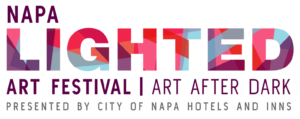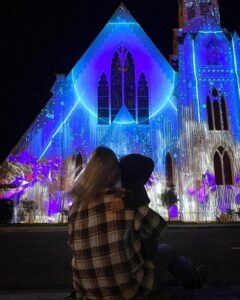

Celebrating its fifth annual event earlier this year, the Napa Lighted Art Festival is a celebration of creative arts, technology and lights, showcasing innovative techniques using light and light technologies as an art medium. 3DVDT has proudly supported this festival since its inception by providing the 3D models of the historic downtown Napa buildings that serve as the canvases for the stunning digital light projection mappings, the fan-favorites of the festival.
Projection mapping is a video projection technique in which footage is mapped onto a surface to turn common objects, in this case buildings, into a dynamic experience of light and illusion. Whole buildings appear animated and when combined with audio content the experience is highly engaging. With our passion for historical preservation, it is especially fulfilling for us to take part in these installations that interact so beautifully with the buildings’ architectural elements, bringing the intricate buildings to life and telling a story.
3D scanning technology not only makes this art form possible, but also enables easy collaboration internationally with artists from around the world. The buildings are captured using 3D laser scanning technology, from which the 3D models are created and delivered to the artists who then realize their vision through their creative digital process. To learn more about the experience from the artists’ perspective, we spoke with Professor Luca Pulvirenti from Sicily. This year he created the captivating digital experience on the 150-year-old Presbyterian Church, an outstanding example of late Victorian Gothic architectural styling.
Can you give a brief summary of your creative and technical process for video/projection mapping?
“We developed a unique workflow for the application of traditional analogue techniques to the large facade ”surfaces”. Such workflow it’s fully deployed to a non-linear production rich in creative contamination and vivid experimentation. To produce our frame-by-frame animation we also curate set production, lighting, fabrication and props making, and combine stop-motion animation, generative design and digital match moving for a unique final aesthetic. As a creative studio we focus on sensitive environments, creating interactive and compelling storytelling. With “Hands of Time” we aimed to develop a digital experience where involvement unfolds towards a collective and emotional participation.”
What was your inspiration for creating “Hands of Time”?
“Hands of Time” is a piece developed during the pandemic crisis, when everyone was looking for meaning. It’s calling for a universal message realized through the creative spark, from illusion to self-discovery. An emotional adventure, a plot in chapters in the search of inner courage towards any creative contend for freedom.”
When did you become interested in digital art, and why?
“When I was a kid I was amazed by cartoons, like every child I would say. My father showed me a cartoon with a 8 mm projector in the house; he would mount the film reel in the projector and then switch on the lamp of the machine. The light would soon start to flicker inside the shutter and the film would advance through the plate, revealing the magic of motion…and so I was astonished. I was very excited by the characters getting alive. This was a kind ceremony for me and I have a very vivid picture of this in my memory. I think this strongly motivated me when I later decided to study animation. As a student I was lucky to find the right environment and some great teachers, and this fueled my dream. I would say that digital art later came as a natural evolution of all these life experiences. I strongly acknowledge video projection in public space as an expanding evolution of the cinematic depiction.”
Learn more about Prof. Luca Pulvirenti and his company mammasONica at www.mammasonica.com

